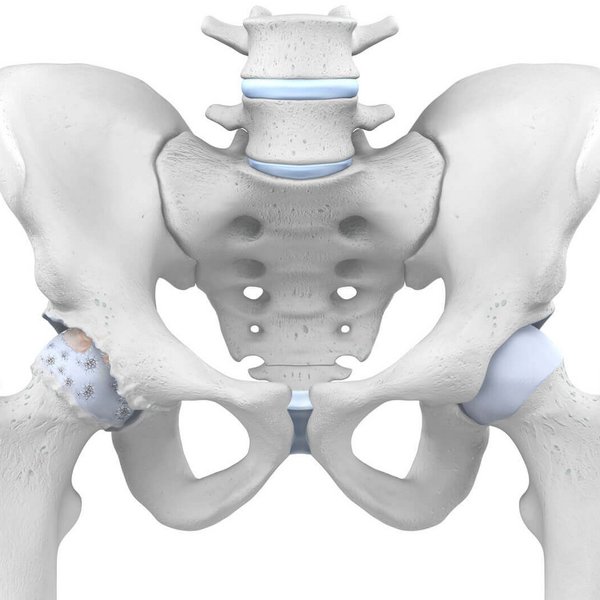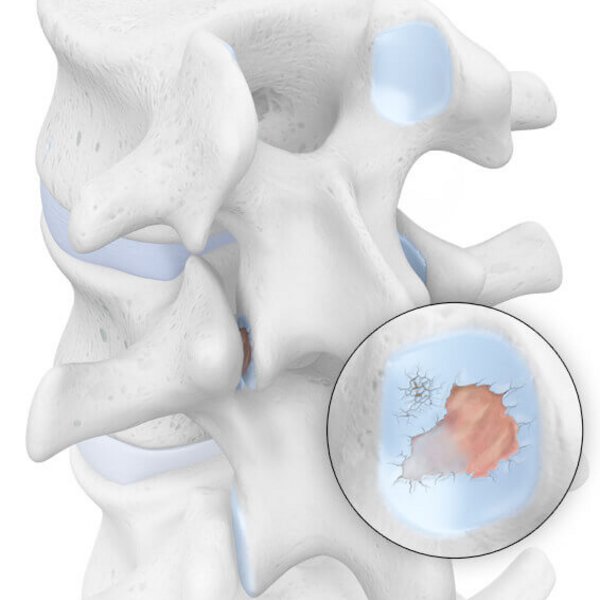Owing to people’s constantly increasing life expectancy, the number of degenerative conditions also increases. When this kind of wear affects the joints, the condition is referred to as osteoarthritis. However, other factors can also advance joint wear, meaning that, for a long time now, this condition hasn’t solely been a sign of ageing: more than one in ten Germans suffers from osteoarthritis. In those affected, the protective layers of cartilage in the joints break down – the knee and hip are affected most often. Joint osteoarthritis may not be curable but its progression can be slowed down with different non-surgical treatment options. We’d like to help you understand the condition better and we’ll explain how you can actively combat pain caused by osteoarthritis.
The most common forms of arthrosis
What is osteoarthritis?
Osteoarthritis is commonly known as joint wear. As you can see in the image, the undamaged area of the cartilage layer, which is responsible for protecting the contact areas of the bones, reduces. The progressing cartilage breakdown causes pain and restriction of movement. In the final stages of joint osteoarthritis, the cartilage disappears completely in some areas and the bones rub directly against each other.

How does osteoarthritis develop?
With osteoarthritis, the cartilage that surrounds the contact surfaces of the bones in joints wears away. Over time, this causes pain, and movements become less fluid. This change occurs more frequently in elderly people, often without any recognizable cause, and is known as primary osteoarthritis. Secondary osteoarthritis, which can also occur in younger patients, is caused by external factors, such as obesity, misalignments, genetic predisposition, and excessive strain. "Activated osteoarthritis" is particularly critical for patients, as it is characterized by inflammatory episodes within the joint capsule, which release substances that often cause the condition of the cartilage to deteriorate rapidly.
Can osteoarthritis be cured?
Osteoarthritis is a condition that develops slowly and for which there is no complete cure. However, receiving treatment – and the earlier the better – is a very effective way to stop it from getting worse. There is no magic cure for osteoarthritis but the combination of different conservative treatment options can help delay surgery and reduce joint pain: the reduction of excess weight, for example, provides the joints with noticeable relief. A healthy diet that is suitable for osteoarthritis not only helps with weight loss but can also contribute to inhibiting inflammatory processes in the joints. Regular targeted exercise with moderate exertion, in particular, is indispensable for osteoarthritis patients to supply the joint cartilage with essential nutrients and to preserve joint function. Our supports and orthoses will help you during physiotherapy and sports that are gentle on your joints.
Medical retailers provide quick help
You can get our supports and orthoses – specifically developed for osteoarthritis patients – from a medical supply retailer near you, even without a prescription from your physician.
Get in-store advice on our products now.
Frequently Asked Questions about osteoarthritis
The first symptoms of osteoarthritis often appear in the form of pain when moving after long periods of inactivity, such as after getting up in the mornings. If the pain continues for several days, you should consult a doctor. The doctor will carefully examine the affected joint and determine how mobile it is, where the painful areas are, and whether there are any swellings or warmer areas. X-rays, magnetic resonance imaging (MRI), and computerized tomography (CT) will reveal the precise condition of the joint. An arthroscopy is the best diagnostic tool, although there are some risks associated with the procedure, such as vascular or nerve damage.
Osteoarthritis is a process where the cartilage in the joint reduces. There is currently no treatment with medication that can restore the joint cartilage. However, there are options for treating the symptoms in order to counteract deterioration.
Of course, the treatment strongly depends on where the osteoarthritis has developed. Do not subject your joints to consistently high strain; wear a support or orthosis during demanding activities to stabilize the joint. Physiotherapy or occupational therapy can also reduce pain and restrictions of movement. Cooling reduces joint pain, while heat relaxes the joint-stabilizing muscles and stimulates circulation.
If quality of life decreases drastically because of osteoarthritis, only surgery can help in some cases, such as an arthroscopy or the implant of a joint endoprosthesis.
In some cases, non-surgical treatment may not be enough: the affected joint continues to hurt and the osteoarthritis progresses. This is when surgery, for example an arthroscopy with cartilage replacement, cannot be avoided any longer. If osteoarthritis is in a particularly advanced stage, only an artificial joint replacement will help to restore the patient's mobility.
There is currently no medication to restore the cartilage. That is why the treatment of symptoms is the focus in cases of osteoarthritis. Pain-reducing medication and creams as well as physiotherapy and occupational therapy can also help alleviate pain, as does wearing a support or orthosis. At the same time, these measures can counteract deterioration.
Joint pain can be caused by osteoarthritis and arthritis – the difference can be found in the symptoms: while cartilage damage causes pain in cases of joint osteoarthritis, arthritis refers to temporary joint inflammation. The first signs are joint stiffness in the morning and pain when subjected to strain as well as reddening and swelling. The affected area also feels warm.
Osteoarthritis can occur in different joints and cause various symptoms. Depending on the degree of severity, a support or orthosis has to provide relief, guidance and stabilization, and correct or limit movement. At the same time, muscles can be activated, the metabolism stimulated, or tissue massaged. As you can see, it’s impossible to give a general recommendation if you want to ideally support the joint affected by osteoarthritis. It’s best if you get advice from your physician or an expert at a medical retail store as to which product is right for you.
When you’re suffering from osteoarthritis and your joints hurt, every movement is a challenge. But resting too much can actually make the condition worse. Gentle exercise is important for joint function and helps prevent the vicious osteoarthritis cycle of pain and restriction of movement. Sports that are gentle on your joints, such as yoga or swimming, are suitable. Developing muscles is also important in cases of osteoarthritis to actively stabilize the joints. No matter what exercise you do, we recommend you wear a support or an orthosis to provide your joint with additional protection and stabilization.
You might also be interested in this














